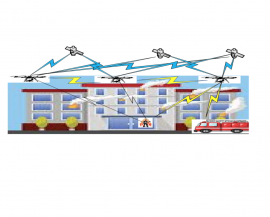
Low-RF Fast Deployable Systems for Emergencies in Difficult Environments
DESCRIPTION
There exist a number of applications requiring reliable and accurate navigation services in environments difficult to access where available commercial products struggle to satisfy the variety of user demands. Such applications include very deep indoor applications, for which navigation accuracy and timely operations are critical to users, as for example in emergencies or underwater/urban-canyon situations.
For the most challenging scenarios, for example in-depth indoors or even disasters resulting from avalanches, flooding, etc., a solution based only on GNSS will not adequately support the PNT functions and operations required for the different environments and operation modes. On the other hand, customised deployable navigation systems will require a highly flexible configuration, to provide robustness along with high-accuracy navigation and timing performances to the distressed users and core operating rescue teams. This will be needed for the entire operation to cope with the dynamic, unpredictable environments and performance requirements. The input design parameters of such a system therefore need to be defined and consolidated, capturing the trade-offs in the parameters critical to its performance, considering different crisis modes, user needs and user surroundings.
The main objective of the proposed activity is to:
- Set up a proof-of-concept platform able to meet the selected challenges, with sufficient versatility to address crisis situations in very harsh environments.
The tasks to be performed will include:
- Review the existing and firmly planned systems and the potential environment of applications that cannot be accessed by existing PNT system solutions. Define the requirements for such applications in terms of PNT with the associated figures of merit;
- Identify the most appropriate carrier for the broadcast platform (drone, helicopter, tethered balloon, small zeppelin, transmitter installed on roof of nearby building, large birds equipped with small transceivers, GNSS transceivers, etc.);
- Investigate the impact on RF propagation of the various environments where this system will be operational to assess the benefits of different signal types, (i.e. frequency bands, bandwidths, transmission mode) per environment (material, environment structure: building, potentially collapsed construction, block, city, etc.);
- Assess the benefits of Radio Frequency for Underwater PNT cases, integrating the benefits of platforms that can provide wide area availability to the applications and services;
- Trade-off pros/cons of potential platform solutions using custom RF signals or making use of GNSS signals, provided that the system operator owns a license, and identify the benefits and advantages with respect to the Rx complexity, re-using current receivers. Define the requirements for the user receiver technology to extract the benefits of such a system;
- Assess the pros and cons of different system architectures, including signals, for the different user cases based on PNT figures of merit. Trade-off and identify the optimal working points of the signal types, versus user conditions, performance requirements and technological constraints;
- Study and derive innovative techniques for the provision of service robustness and enhancements for the PNT links in local environments and different application areas. Define the required technological aspects for the implementation of a networked system to support flexibility in the targeted application;
- Develop a platform, capable of assessing and testing in representative conditions (environment, system architecture), the critical technologies and key enablers (for instance, different signal configuration, network architecture of deployable platform, target performances).
The results of the activity will provide:
- A proof of concept by means of field data collection, for different user environments and PNT target performances;
- Recommendations for follow-on activities aiming at development of a prototype system.
esa-STAR link: http://emits.sso.esa.int/emits/owa/emits.main
